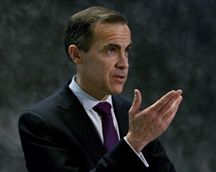
OTTAWA - Bank of Canada governor Mark Carney gave his most explicit warning to date that higher interest rates are coming, and perhaps sooner and higher than previously thought. The bank governor has always maintained that his promise to keep interest rates at historic lows was contingent on inflation remaining tame, but Wednesday issued a clear alarm that he is worried about prices.
And in a speech before the Ottawa Economic Association, he underlined just how qualified his commitment to keeping the policy rate at 0.25 until at least July has become.
"This commitment is expressly conditional on the outlook for inflation," he stressed.
Carney also noted that core inflation, the measure the bank uses to judge underlying price pressures, has been "slightly firmer" than projected.
Last week's Statistics Canada report that core inflation - which excludes volatile items such as energy - had peeked above the bank's two-per-cent target to 2.1 in February likely was the last piece of evidence Carney needed to start publicly worrying about inflation.
Many economists say markets have already priced in a quarter-point increase by Carney if not at the next earliest opportunity, April 20, then at the next scheduled announcement date on June 1.
But some had wondered whether the governor was willing to be seen going back on his word, even though it was always couched in what if language, if he risked losing a degree of credibility.
In his address, excerpts of which were released before he began his 1 p.m. address, Carney makes it clear he believes everything is advancing quicker than he thought would occur the last time the bank issued an economic forecast in January.
Economic activity around the world is somewhat higher than projected, he said.
In Canada, "economic activity has surprised slightly on the upside in recent weeks," he said, adding: "Growth has been driven mainly by domestic demand, but exports have also recovered further in response to improving external demand."
He said government stimulus and low interest rates, combined with increased confidence and improved financial conditions, as well as the higher prices commanded for Canadian natural resource exports, were the major factor in the improving economic conditions.
Carney did not issue an updated forecast from the 2.9 per cent growth he projected in January for this year, but given that most private sector forecasters have now moved north of that target, the bank also will likely move up its projections next month.
Though the interest rate warning will likely draw the most attention from markets, Carney's main focus in his address to the business audience is that Canada faces a significant long-rate problem because of its dismal productivity record.
Carney calculated that unless the country improves its productivity, output per unit of work, Canadians can expect to lose a total of $30,000 in real income over the next decade.
"Canada does underperform," he said. "We are not as productive as we could be. Our potential growth is slowing. Moreover, this is occurring as the very nature of the global economy ... is under threat."
Carney noted that Canada's productivity advanced a meagre 0.7 per cent annually over the last decade, less than half the rate in the U.S. and half the rate Canada managed between 1980 and 2000. In fast, productivity declined outright during the recession, the first time that has occurred in three decades.
He lays the blame at the doorstep of Canadian business, who he compares to the grasshopper in the fable of the grasshopper and the ant.
"Canadian grasshoppers, perhaps basking in the historically easy access to the U.S. market and the relative abundance of resource opportunities, could be in danger of wasting their days in the sun and finding themselves unprepared for the winter to come," he cautioned.
His prescriptions are not new. Canadian firms need to invest in machinery and equipment and in information technologies. He said Canadian workers have about half the information and communication technology at their disposal as their American counterparts.
Carney also said a key to future prospects for the Canadian and global economies is adoption of the G20 framework for economic sustainability, which will require in addressing global imbalances of countries like China, which set their currencies at low levels to increase exports and limit imports.
He produced a chart showing that unless the unless the G20 measures are adopted, global growth will be about one percentage point lower in the next five years than it might otherwise be.
Please contact Shaun directly shaun@shaunkimmins.com to discuss whether it's a good time for you to buy or sell and please feel free to comment on this or any of my other Blogs or visit me at my Century 21 In Town Realty website.
